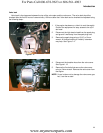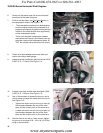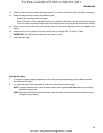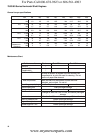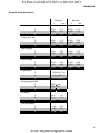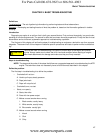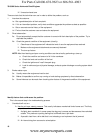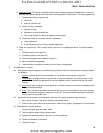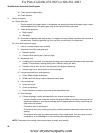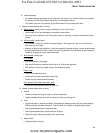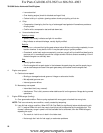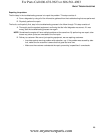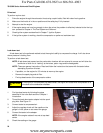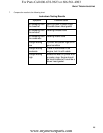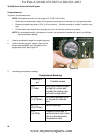
BASIC TROUBLESHOOTING
19
D. Rope jerks back. This usually indicates that the piston is stopping before top dead center on the com-
pression stroke and is being driven back down by compression or combustion. The likely suspects are:
I. Compression that is unusually high.
a. valve lash.
b. a partial hydraulic lock.
III. Ignition timing is advanced.
a. Improper air gap.
b. Sheared or missing flywheel key.
c. The wrong flywheel or module is installed on the engine.
IV. Insufficient inertia to over-come normal compression.
a. Loose implement.
b. A light flywheel used on a heavy flywheel application.
C. Rope will not pull at all. This is usually either a quick fix or a catastrophic failure. The likely suspects
are:
I. A broken starter recoil (easy fix).
II. Complete hydraulic lock (easy fix).
III. External binding/jammed implement (easy fix).
IV. Bent crankshaft (unrepairable)
V. Internal binding, crankshaft, connecting rod or piston (unrepairable)
2. Crankshaft turns, no start.
2a. Most gasoline engine diagnosis involves isolating problems in the four critical factors an engine needs to
run properly:
I. Ignition- sufficient spark to start combustion in the cylinder, occurring at the right time.
II. Compression- enough pressure in the cylinder to convert combustion into kinetic motion. It also
needs sufficient sealing to generate the vacuum needed to draw in and atomize the next intake
charge.
III. Fuel- correct type and grade of fresh gasoline; in sufficient quantity, atomized (tiny droplets) and in
correct fuel/air proportions.
IV. Flow- if all of the above conditions are met but the flow of air is constricted on the inlet or exhaust
side, it will cause the engine to run poorly or not at all. This also includes ensuring the valves are
timed to open at the proper time.
2a. Isolate the ignition system and compression from the fuel system by preforming a prime test.
I. Burns prime and dies. This would indicate a fuel system issue.
II. Does not burn prime. Not a fuel system issue. Check for an ignition, compression or flow problem.
2c. Compression or ignition problem
I. Check the engine stop and safety switch.
II. Test the ignition system using a proper tester.
III. Replace the spark plug with a new one or a known good one.
IV. Check compression or leak down.
V. Check valve lash.
For Parts Call 606-678-9623 or 606-561-4983
www.mymowerparts.com



